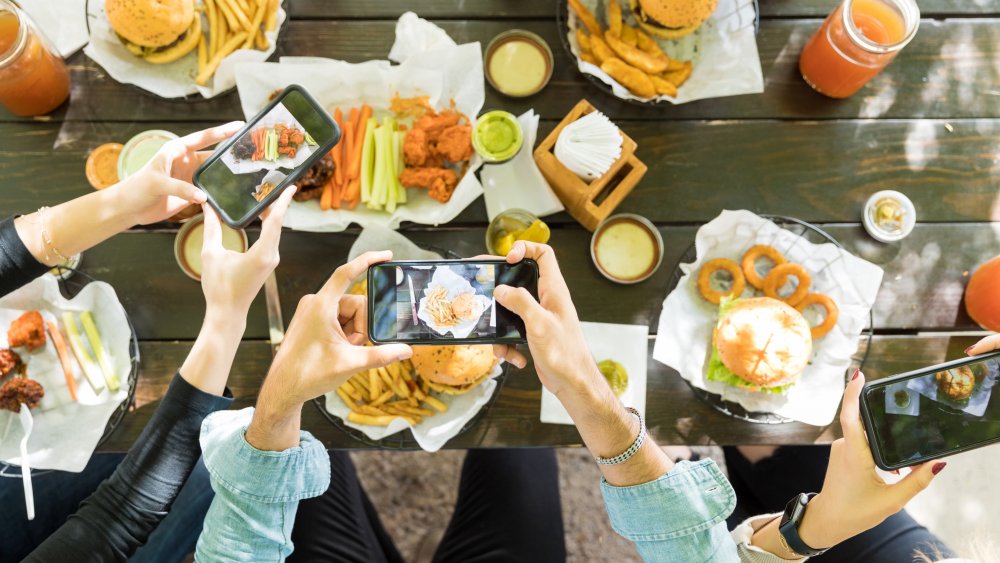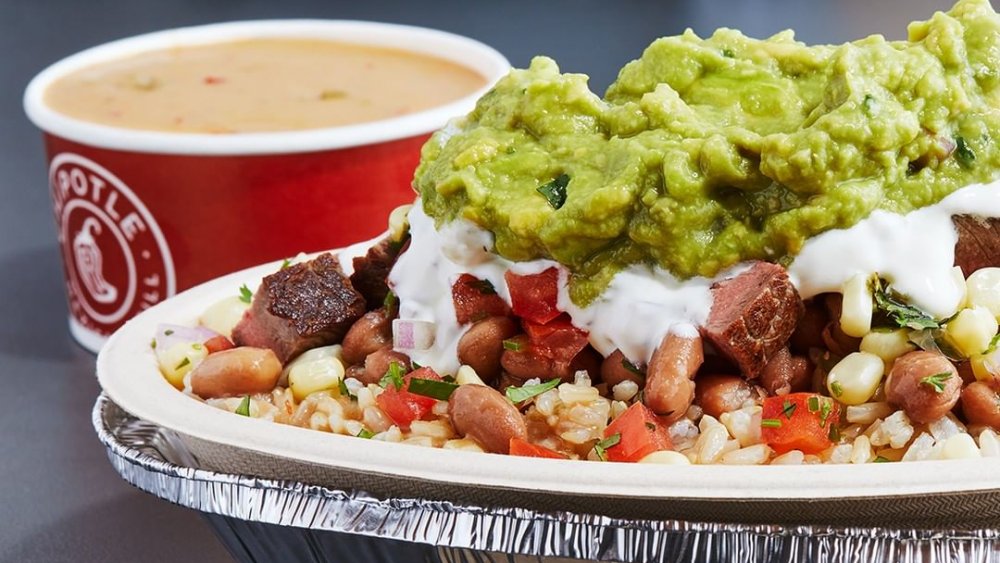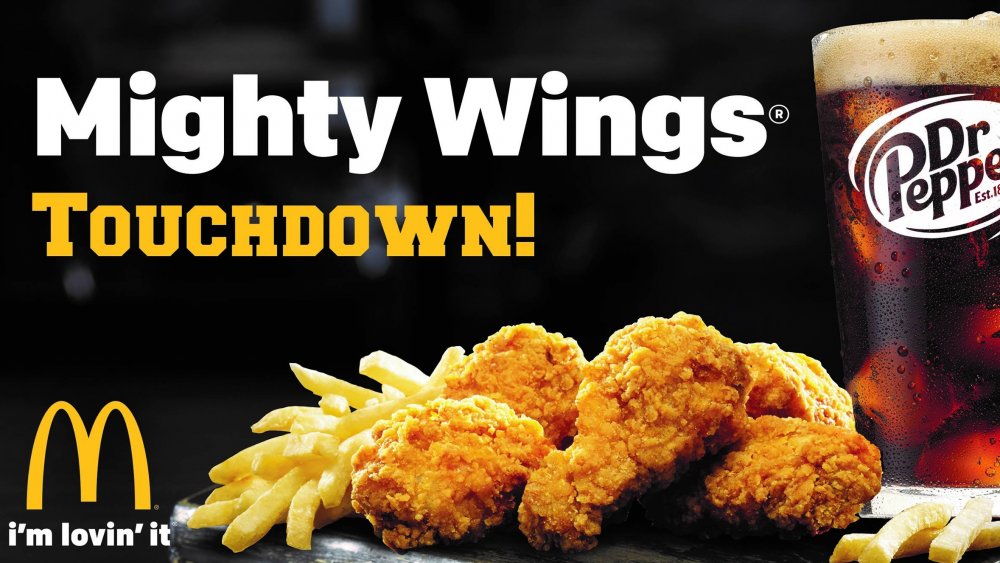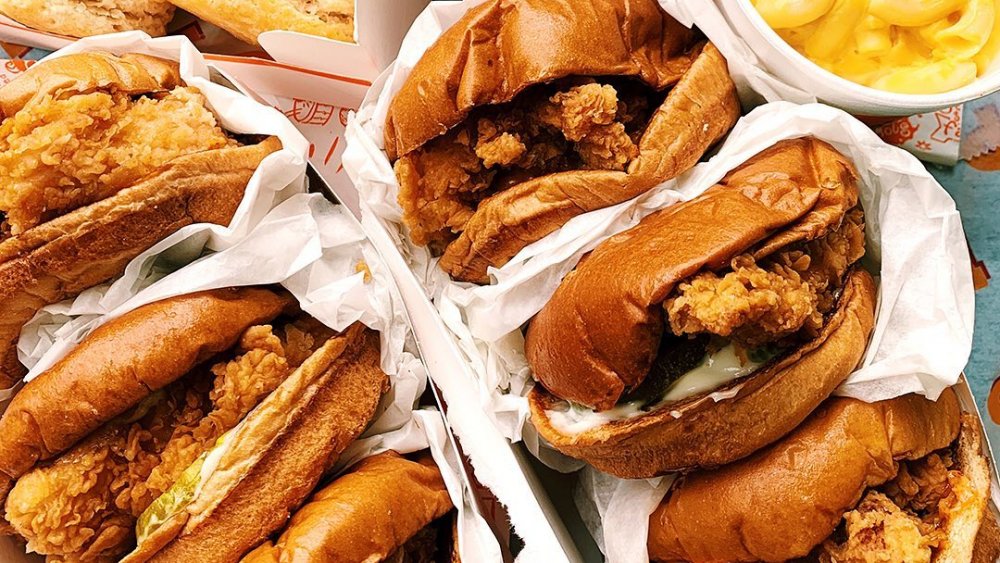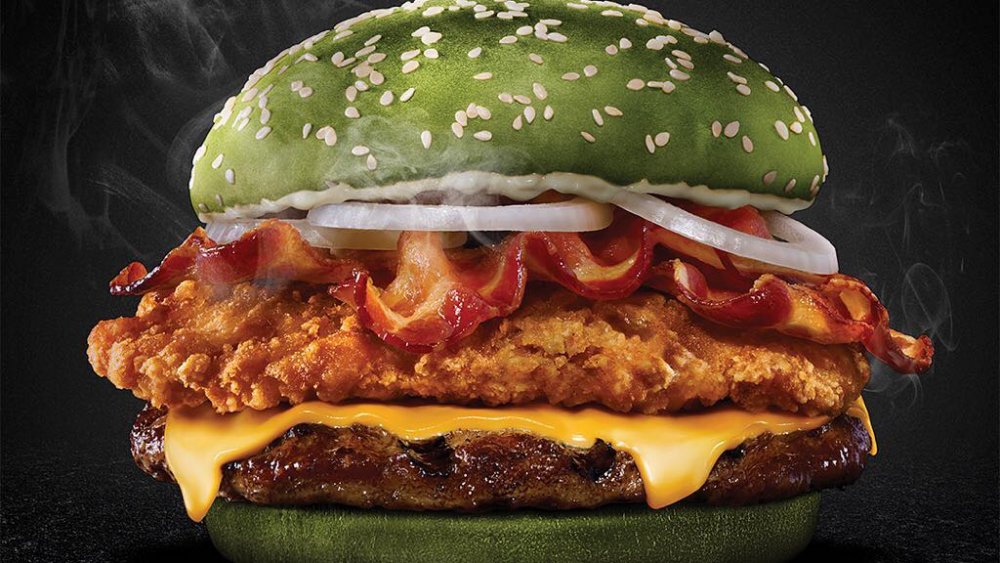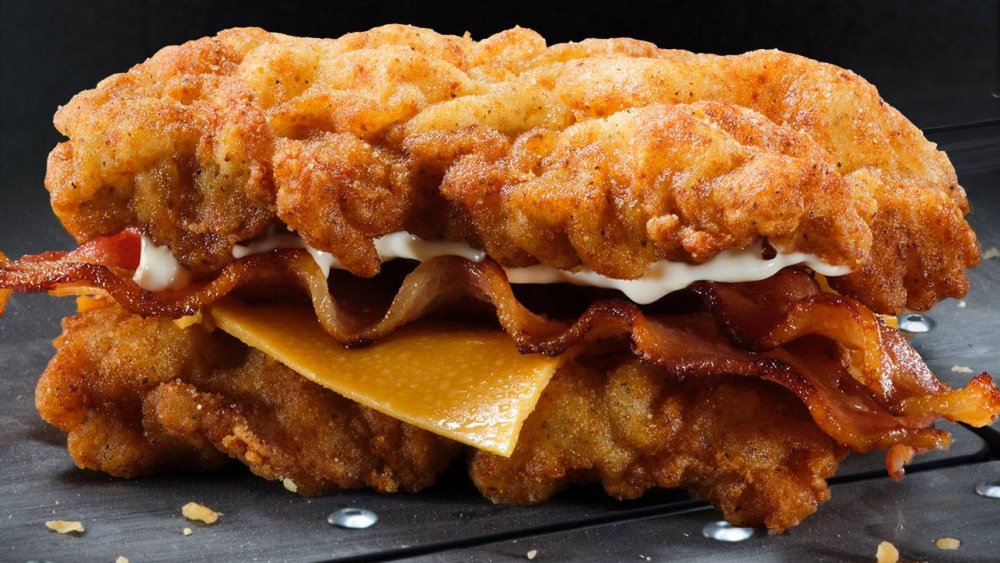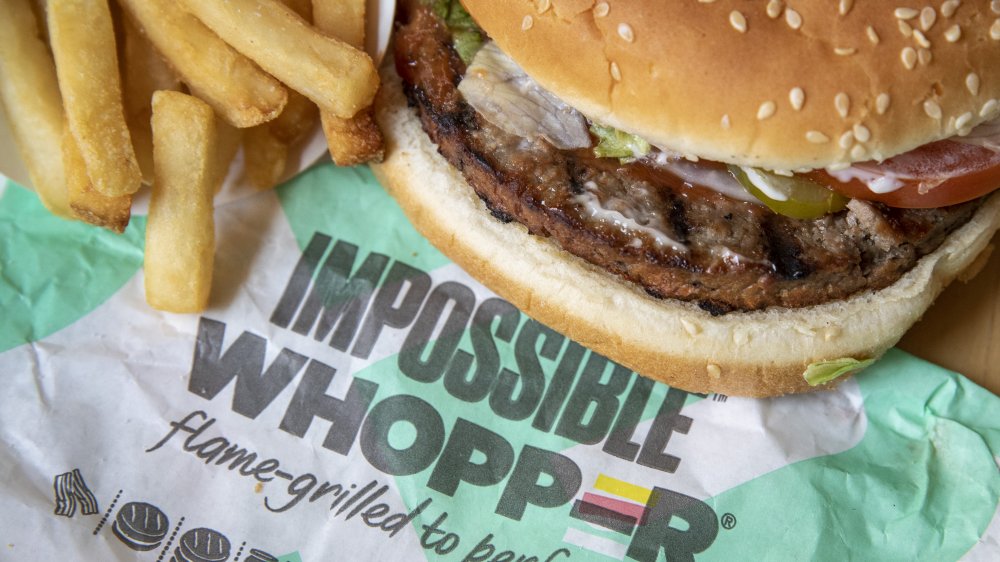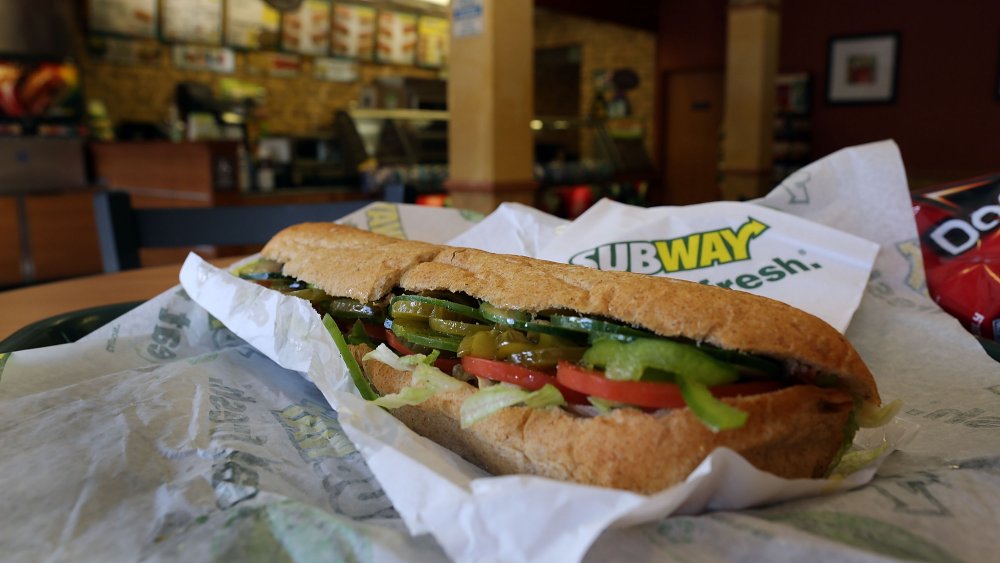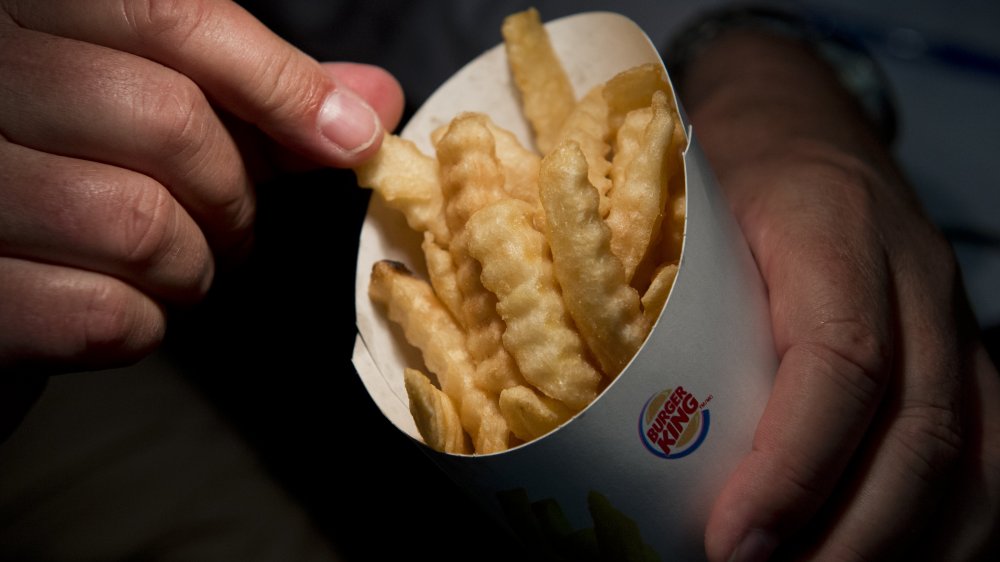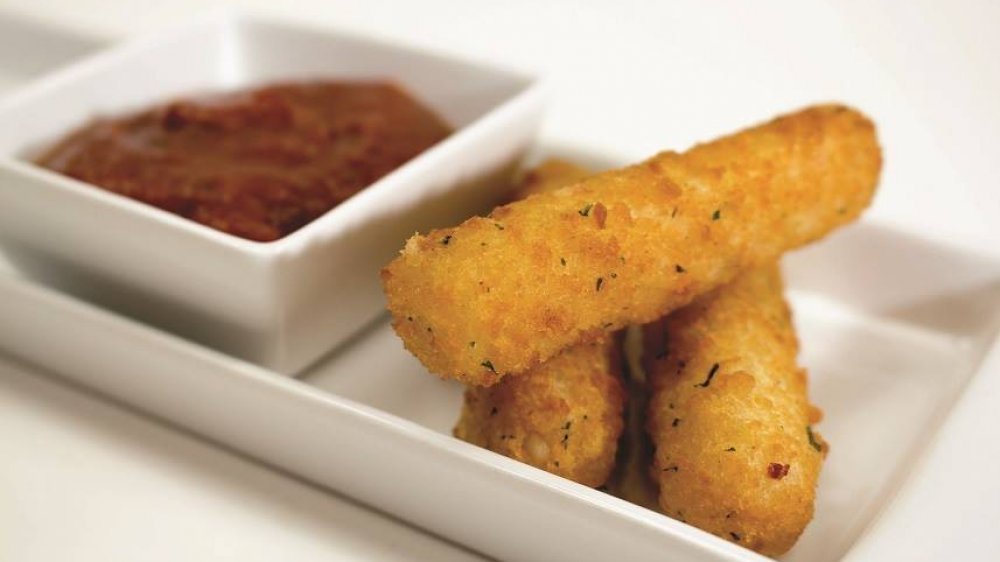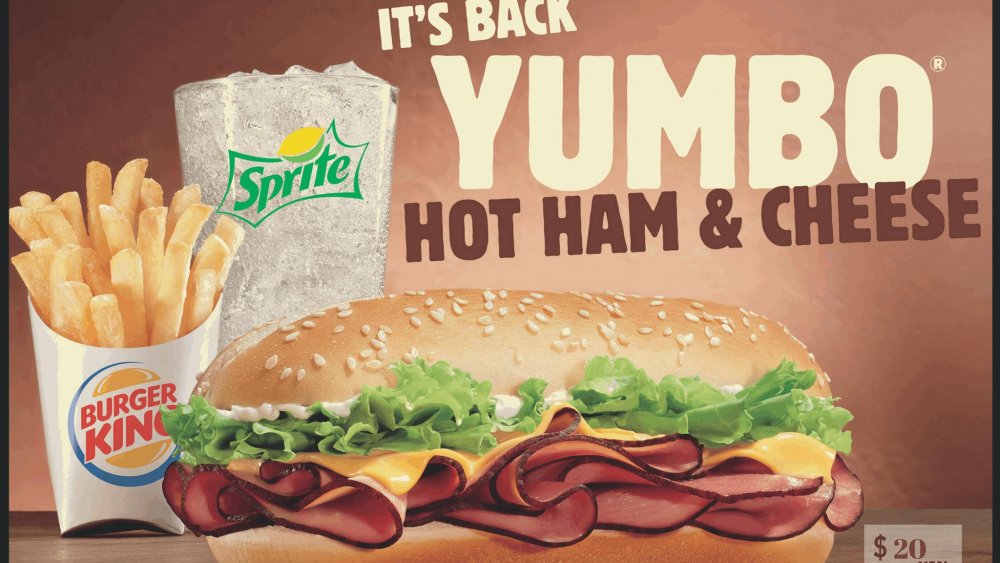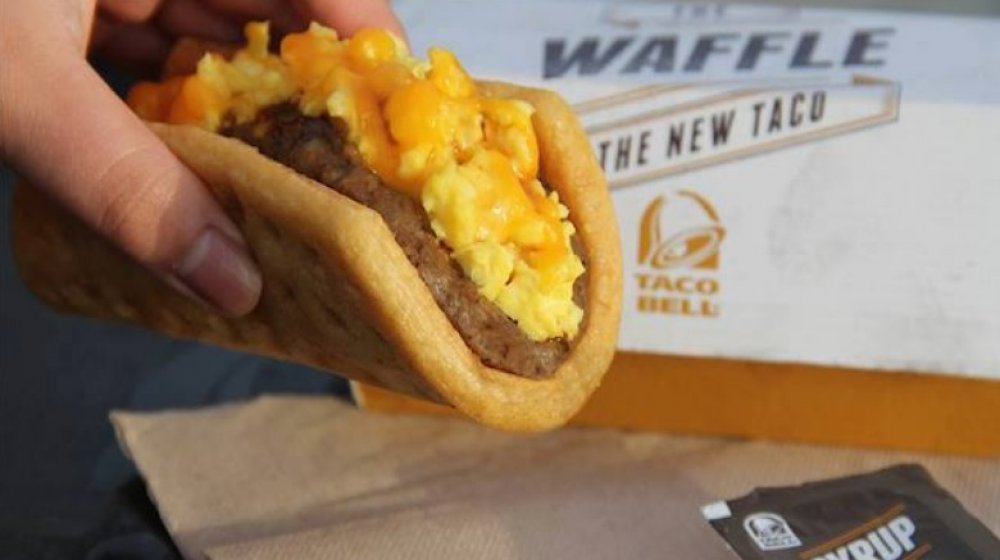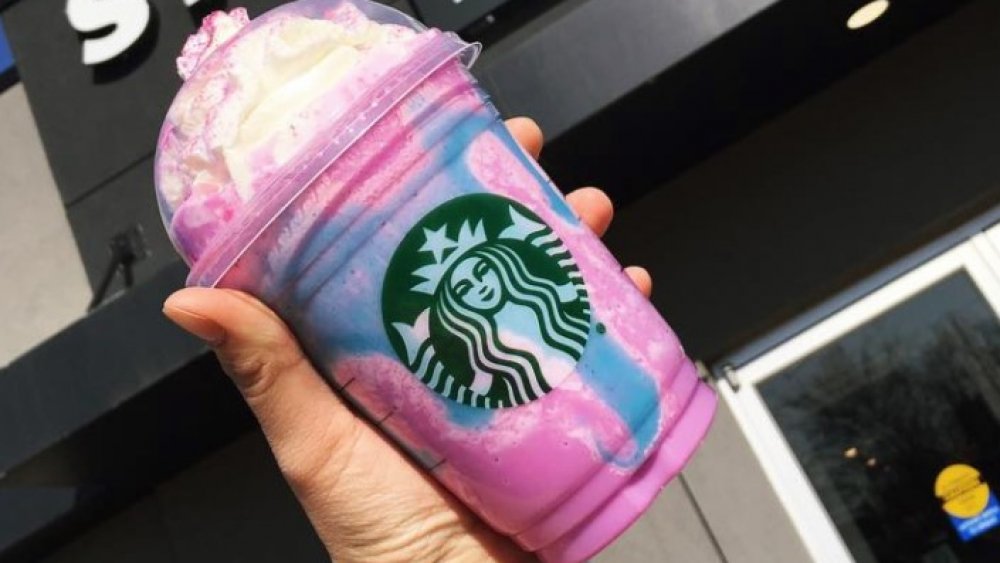The Most Over-Hyped Fast Food Items Of The Last Decade
Every time a fast food chain releases a new product, they hope it's going to be the next Whopper or Big Mac. They hope it's going to go viral, that everyone is going to be clamoring for it, that everyone is going to be sharing pictures and... well, maybe not stabbing their fellow customers over it, but sometimes, that happens, too.
Because of course it does.
Getting the word out about a new product is crucial, but sometimes, it's possible to over-hype a new item — and there's a danger in that, too. Customers can be left seriously disappointed when something doesn't live up to the hype, or, even if it does, things can still go very, very bad.
Sometimes companies can get so carried away they make claims that aren't entirely true, and you'd better believe people on social media are going to call them out on it. Looking back, you'll find that 2010 kicked off a whole slew of over-hyped products. Remember these?
Chipotle queso
Even die-hard fans of Chipotle have been forced to admit that for a long time, there was something missing. That was, of course, queso, and in 2017 the chain made a huge deal about finally adding it to their menu. And they did it in typical Chipotle fashion, says USA Today, which was by making a big deal out of offering the better, healthier, fresher queso. That's what everyone wants, right? It turned out that it sounded better than it actually was, and people mostly hated it.
It was derided as having a texture that was everything queso is not supposed to be, starting with grainy. The response was, at best, the opinion that it was just "ok," but the majority of responses were that it was downright awful — so bad, says The New Yorker, that Chipotle shares dropped three percent.
Chipotle tweaked their recipe, and in August 2019 they announced (via CNBC) that they were testing a replacement queso. The heart of their problem still remains, though. As much as Chipotle wants to toot their own horn-of-freshness, that's just not what the spirit of queso is. Queso is Velveeta and Ro-Tel, microwaved goodness that might not be healthy, but is downright delicious. Making it healthy takes away what makes it queso, and that's pretty much the definition of a travesty.
McDonald's Mighty Wings
Chicken wings are great, and seriously, who doesn't love them? It seems like they would have been an unconditional win for McDonald's when they introduced their Mighty Wings in 2013, but things don't always work out the way we plan.
Mighty Wings just didn't take flight in quite the way McDonald's had expected, even though AdAge says they partnered with the NFL for a massive marketing campaign. But according to The Huffington Post, there were problems right from the beginning.
First, there was the price: $1 per wing is steep, both for wings and for McDonald's. It doesn't really matter how good they are, with everyone and their cousin making and selling wings, it's a tough sell to get people to spend that much on wings at McDonald's. And the consumers spoke: the fast food giant initially purchased 50 million pounds of wings, and when they flopped, McDonald's had millions of pounds of overstock left.
The Street reported that McDonald's brought their wings back in 2016. It was proof that they haven't quite given up on hyping the heck out of these classic 1990s... well, failures.
Popeyes' chicken sandwich
When Popeyes released their chicken sandwich at the end of 2019, it put American consumerism front and center on the global stage — and not in a good way. We covered the release of the sandwich from start to finish (including it's untimely end and it's valiant return) and if you think it's the sort of event that wouldn't warrant that kind of coverage, you missed the chaos.
When it first hit stores, it was so popular that it quickly sold out. That left people clamoring for more, and when we say "clamoring," we mean "fighting each other in the parking lot." Things didn't get any better when they re-released the sandwich a few months later, promising to be able to meet the demand for this thing that was, at the end of the day, just another chicken sandwich. In fact, it's not even the best fast food fried chicken sandwich out there.
Almost predictably, they couldn't. Here's where things get dire.
Popeyes, their customers, and everyone on social media had made such a big deal over the sandwich that people quite literally lost their minds. More fights started breaking out, cars got destroyed, and at least one person was killed in a fight that started in line for a sandwich. There's hype, there's over-hyped, and then there's out of hand; and Popeyes' chicken sandwich definitely got out of hand.
Burger King's Nightmare King
In 2018, Burger King decided to do something epic for Halloween. That's when they released the Nightmare King, and it wasn't just a funky-colored Whopper. According to their hype, eating one would actually give you nightmares.
Their precise claim (via Fortune) was that the "unique build" of the burger would increase the chances of bad dreams by exactly 3.5 times. They advertised that they had done scientific studies to prove it, feeding Nightmare Kings to volunteers then monitoring their breathing, brain activity, and heart rate during sleep for the telltale signs of bad dreams.
According to LiveScience, it was simply a bit of marketing without substance. There actually have been a few studies done on fast food's impact on dreams, and some even suggest eating a bad-for-you burger before bed makes it less likely you'll have bad dreams.
But, they also say there's a decent percentage of the population out there that believes eating certain foods does cause nightmares. It might be irresponsible science, but it's definitely viral marketing that got people in the door, because... we all need more nightmares and less sleep?
KFC's Double Down
It was the fast food unveil that headlined CNN's piece entitled, "Is fat fare at fast foods going too far?" Depending on how you look at it, that's either hilarious or sad. Why? Because they also reported that it was just 540 calories and 32 grams of fat, which is practically diet food when compared to some other fast food items on the market.
Replacing a bun with chicken filets? Surely, KFC didn't really do that... did they?
Customers in Providence, Rhode Island and Omaha, Nebraska got the first peek, says Eater, and honestly, even when rumors started swirling around a release in those cities, it was still the sort of thing that made everyone think KFC just had to be pulling their customers' leg. It didn't help when they chose April 1, 2010 to announce they were going on sale, and just a few days later, a countdown clock showed up on their website.
It was real, customers soon found out, and after all the hype, a lot of people were still shocked. Tree Hugger called it "the Vilest Food Product Created by Man," and in addition to getting people running to their local KFC, it had many doing some serious soul-searching about who we are as a nation.
It's disappeared and returned a few times since that original, not-quite-April-Fool's ad campaign, and as The Washington Post reported, they made it better/worse with their 2015 version: a hot dog with chicken as a bun (but only in the Philippines).
Burger King's Impossible Whopper
In 2019, Newsweek reported that more and more people were switching to vegan diets. There are plenty of carnivores that are trying to make a move toward more plant-based and meat-free meals, so the announcement of Burger King's Impossible Whopper was a huge deal.
Customers didn't have to be vegetarian to be intrigued by just how well these claims of meatless burgers that tasted just like meat were going to hold up, and according to the hype, it was going to change the way people thought of fast food.
Was it? Reviews were mixed. The Miami New Times said that the Impossible Whopper was a legit contender, and definitely worth it. Forbes condemned it as bland and dry, although they also said it definitely wasn't good as a burger made with Wagyu beef and topped with sherry vinegar-soaking pickles... so they may be a little unrealistic in their expectations.
The real problem, says Business Insider, was that it took the world a while to realize "plant-based" wasn't the same as "vegetarian."
Burger King never claimed the Impossible Whopper was vegetarian or vegan — they even went on record as saying it was cooked on the same equipment as regular meat burgers — but that little bit of info got lost in the hype and angered a lot of people when they finally figured it out.
Subway's $6 footlong
Subway has had a tough time in recent years, and there are a ton of reasons for their struggles. According to Vox, many franchisees pointed to the $5 footlong as just one of many horrible things they needed to deal with, as it cost them more than $4 to make, and profits were nonexistent.
That's understandable, and most reasonable customers would agree that restaurant owners need to make a profit to keep their doors open. But in 2016, Subway tried to hype a new deal and get customers excited enough to come back in with an ill-conceived plan: offer the $6 footlong. Business Insider says that went about as well as literally everyone outside of Subway corporate could have predicted; their hype was a two-fold problem.
One, everyone was still singing that $5 footlong jingle (it's in your head right now, isn't it?). Two, they hyped this new deal as something not just new but awesome and exciting... when it was very obviously the same old thing, costing customers more money. Not cool, Subway.
Burger King's Satisfries
There are a lot of people looking for small ways to make healthier choices, so it seems pretty logical that healthy french fries would be a total win. Burger King thought so, too, and according to Entrepreneur, most of their advertising in the end of 2013 and into 2014 focused on Satisfries.
They gave them away for free, they took regular fries out of the kids' meals and put in Satisfries, and they plastered them across social media. Early successes meant they started hyping them in Europe not long after they hit the American market, but by summer of 2014, they had been dropped from most US and Canadian menus.
That was incredibly anti-climatic, especially for a product that had been the darling of the chain's PR campaign only a few months before. So, what happened? Why didn't people buy the hype?
According to The Motley Fool, there were a few big problems that meant Satisfries were just doomed not to live up to the hype. First and foremost, it's hard to improve on a classic staple like fries. Satisfries were still higher in calories than the same size fries at McDonald's, and a small order of Satisfries was more expensive than Burger King's regular-size fries.
For all the hype, they forgot to include one thing: what made them healthier, what the actual difference was, and why they were worth the extra cost.
McDonald's mozzarella sticks
Remember when McDonald's announced they were going to be adding mozzarella sticks to their menus? Of course you do, because it was impossible to miss. It was announced at the end of 2015, and Business Insider says McDonald's hyped it as not so much a side, but a snack. They wanted to get people stopping by for something other than a whole meal, and quick finger foods seemed like a legit answer.
And honestly, who doesn't love mozzarella sticks?
As it turns out, just about everyone who tried McDonald's version. It was a classic case of the product just not living up to the hype at all, and that was all painfully clear when McDonald's found themselves on the receiving end of a class action lawsuit. Why? Customers were calling foul on their claims they were selling mozzarella sticks made with "100 percent mozzarella."
Those that did buy into the hype and order those ooey, gooey, mozzarella sticks found they weren't really ooey and definitely weren't gooey, because there was a little more starch in them than traditional cheese should have. Also, according to Delish, it went from bad to worse when customers started finding a large number of the sticks served decidedly lacking in the cheese department — some of the mozzarella sticks having lost their cheese completely during the frying process.
McDonald's called it a "rollout glitch," but people were less than happy to accept that sort of explanation.
Burger King's Yumbo
A weird thing happened at Burger King in 2014. According to The Huffington Post, it all started when they announced they were going to be reviving an old favorite, 40 years after it was removed from Burger King's menu. The sandwich was the Yumbo, and it was basically a hot ham and cheese sandwich that was dropped from the menu in 1974.
Burger King played up the nostalgia theme hard, right down to their '70s-inspired color palette for their advertising, and appeals to give them a call on your push-button, land-line connected telephone. Everyone loves the '70s, right? But, there was a bit of a problem... people started posting on social media saying they were definitely alive during the '70s, they had definitely gone to Burger King, and didn't have the foggiest idea what a Yumbo was.
That led to a widespread belief that Burger King had just made up a discontinued sandwich just so they could hype the heck out of it and cash in on the nostalgia factor. Snopes even got involved in the conspiracy theory, and tried to clear up the fact that yes, there really had been a Yumbo in the 1970s. They suspected memories got a little hazy because most people on Twitter weren't old enough to remember 1974, and that those who were old enough to remember the sandwich weren't in Burger King's target demographic. In this case, hype just led to a ton of confusion.
Taco Bell's Waffle Taco
Quite possibly, the only thing better than Taco Bell is Taco Bell for breakfast. According to Eater, they made a massive menu revamp in 2014, and it included breakfast items like the Waffle Taco. It was understandably a huge deal, and it was deliciously brilliant. It wasn't as weird as it sounded at first glance, either, simply breakfast foods wrapped into taco form using a waffle instead of a tortilla. Could this possibly be over-hyped?
Yes, and fans of the Waffle Taco won't like the reason.
Only a year after it was announced, it was replaced by a sort of similar item, the Chicken Biscuit Taco. This replaced the waffle with a taco-shaped biscuit and all that breakfasty goodness with fried chicken (although eggs and cheese were, to be fair, still available).
Entrepreneur says Taco Bell definitely wasn't pulling any punches, either, launching an ad campaign with a totally dystopian feel and evil clowns... as if there are any other types.
Taco Bell was trying to set themselves up as a better answer to the question, "Where should we go for breakfast?" But they did it by teasing us — the Waffle Taco was likely only invented as a wacky menu item to hype up their breakfast offerings, and it should have been around longer.
Starbucks' Unicorn Frappuccino
Starbucks' Unicorn Frappuccino is the very definition of over-hyped. In 2017, this very pretty, very sugary drink was all over social media, and it was what all the cool kids were ordering. That was much to the despair of Starbucks baristas across the country, and according to The Washington Post, baristas were taking to social media to complain about the drink.
From Reddit posts to YouTube videos, it was very clear that no one was happy about it. Not only did it take a long time to make, but the ingredients got everywhere.
But, some jaded customers might argue, that's their job. But others might argue that their job was to make delicious coffee drinks, and that is something the Unicorn Frappucino was not.
Cosmopolitan got opinions from a number of people, and it was overwhelmingly described as way too sweet, weirdly (and indeterminately) fruity, and strangely, it was also described as way too tart. Some people liked it, but many did not. Stephen Colbert said it was only called the Unicorn Frappuccino because "sugary affront to God" was taken, and his response when he tasted it?
"Oh. I wish I was dead. Tastes like I French-kissed Tinkerbell."
Worth the hype? Nah.
